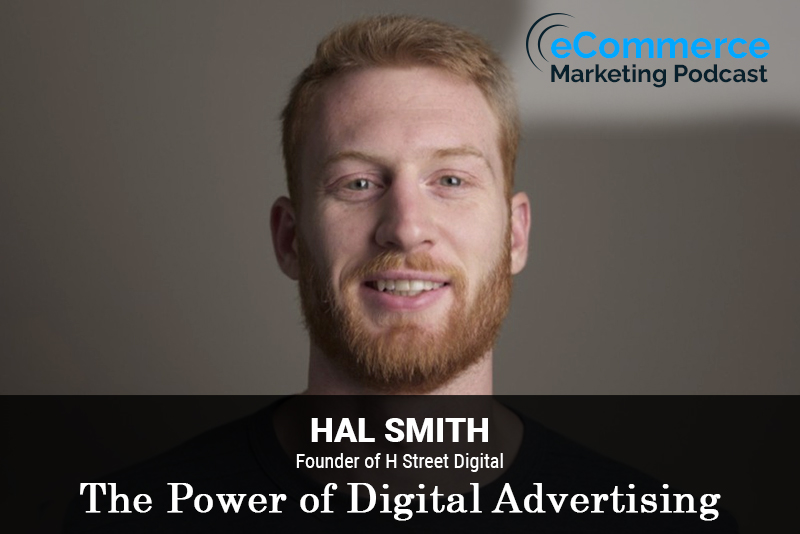
The eCommerce Marketing Podcast walks you through everything that goes into ecommerce marketing — from inbound marketing to paid advertising to conversions. Learn the strategies top marketing experts use to grow their businesses.
Head over to Leadfeeder.com and sign up for a 14-day (no strings attached) free trial!
Hal Smith, the Founder of H Street Digital, is an adept entrepreneur cultivating business growth through data-driven digital advertising. Focused on scaling leads and new customers for consumer brands, his leadership propels the company with triple-digit growth annually. With a track record of managing over $100 million in digital advertising campaigns and a knack for objective data analysis, Hal ensures H Street Digital empowers brands to scale customers profitably.
In this episode, you will learn
- How the landscape of digital advertising is evolving in the next few years, especially with the increasing concerns around privacy and data protection
- What are the most significant challenges brands face today in scaling their customer base through digital advertising, and how does H Street Digital approach these challenges
- In what ways have AI and machine learning transformed digital advertising strategies, and how does H Street Digital leverage these technologies to optimize campaign performance
- The key performance indicators (KPIs) that you should prioritize to assess the effectiveness of a digital advertising campaign
- How do shifts in consumer behavior impact digital advertising strategies, and can you share an example of how you’ve adapted a campaign to meet changing consumer preferences
- Emerging trends and technologies that will have the biggest impact on digital advertising
For show transcript and past guests, please visit https://www.ecommercemarketingpodcast.com
Or on YouTube at:
https://www.youtube.com/@ecommercemarketingpodcast
and other social medial platforms:
https://www.facebook.com/ecommercemarktingpodcast
https://twitter.com/emarketpodcast
https://www.instagram.com/emarketingpodcast/
Follow Arlen:
Twitter: https://twitter.com/askarlen
Facebook: https://www.facebook.com/arlen.robinson.7
Instagram: https://www.instagram.com/arlenyohance/
LinkedIn: https://www.linkedin.com/in/arlenrobinson/
Past guests on the ecommerce marketing podcast include Neil Patel, Nemo Chu, Luke Lintz, Luke Carthy, Amber Armstrong, Kris Ruby and many more.
Thanks for listening. Be sure to subscribe and leave a review.

In this episode of the eCommerce Marketing Podcast, host Arlen Robinson interviews Hal Smith, Founder of H Street Digital. Hal is a seasoned entrepreneur focused on scaling consumer brands through data-driven digital advertising. With experience managing over $100 million in digital ad campaigns, Hal shares his insights on the evolving landscape of digital advertising, data privacy, and the impact of AI and machine learning.
Key Takeaways
- Introduction and Background ([00:02] – [03:06])
- Hal’s transition from political advertising to founding H Street Digital.
- Growth and focus on direct-to-consumer e-commerce brands.
- Impact of Data Privacy and Protection ([03:06] – [11:29])
- The importance of in-house data management.
- Changes brought by iOS 14 and CCPA on data collection and audience targeting.
- The balance between performance advertising and consumer privacy.
- Role of AI and Machine Learning ([11:29] – [14:37])
- Shift from manual campaign management to AI-driven optimizations.
- Importance of creative strategy and landing page optimization in AI-enhanced ad platforms.
- Key Performance Indicators (KPIs) ([14:37] – [17:39])
- Metrics such as hook rate, click-through rate, landing page view rate, conversion rate, and average order value.
- Importance of identifying and reducing friction points in the customer journey.
- Adapting to Changing Consumer Preferences ([17:39] – [22:33])
- Shift towards user-generated content (UGC) for authentic and effective advertising.
- Challenges of maintaining authenticity in UGC.
- Emerging Trends and Future of Digital Advertising ([22:33] – [28:00])
- Generative AI’s potential to create and optimize ads in real-time.
- Impact of data privacy regulations on AI’s learning capabilities.
- The future of political advertising with advanced AI tools.
Guest Info
Hal Smith
Founder of H Street Digital
LinkedIn: Hal Smith
Twitter: Hal4ad
For more information, visit H Street Digital.











